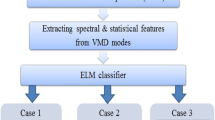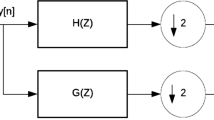Abstract
Neuromuscular disorders are characterized by abnormal functioning of muscles and nerves that communicate with the brain, resulting in muscle weakness and ultimately damage to nervous control, for instance amyotrophic lateral sclerosis (ALS) and myopathy (MYO). Diagnosis of these disorders is frequently done by examining ALS, MYO and normal electromyography (EMG) signals. In the present work, an efficient technique that involves wavelet transform using tunable-Q dynamics (TQWT) is proposed in order to identify disorders related to the neuromuscular domain of EMG signals. The EMG signal is decomposed by the TQWT technique into sub-bands, and these sub-bands are used to determine spectral features including spectral flatness, spectral stretch and spectral decrease, and statistical features including kurtosis, mean absolute deviation, and interquartile range. The extracted features are used as inputs into extreme learning machine classifiers in order to identify and analyze EMG signals associated with neuromuscular dysfunction. The results achieved with this technique illustrate a much better classification with regard to neuromuscular disturbance in electromyogram signals when compared with previous methods.





Similar content being viewed by others
References
Christodoulou CI, Pattichis CS (1995) A new technique for the classification and decomposition of EMG signals. Proc IEEE Int Conf Neural Netw 5:2303–2308
Tsai AC, Luh JJ, Lin TT (2015) A novel STFT-ranking feature of multi-channel EMG for motion pattern recognition. Exp Syst Appl 42(7):3327–3341
Woczowski A, Zdunek R (2017) Electromyography and mechanomyography signal recognition: experimental analysis using multi-way array decomposition methods. Biocybern Biomed Eng 37(1):103–113
Ko KD, Kim D, El-ghazawi T, Morizono H (2014) Predicting the severity of motor neuron disease progression using electronic health record data with a cloud computing Big Data approach. In: IEEE international conference on computational intelligence in bioinformatics and computational biology, pp 1–6
Mishra VK, Bajaj V, Kumar A, Singh GK (2016) Analysis of ALS and normal EMG signals based on empirical mode decomposition. IET SciMeas Technol 10(8):963–971
Fattah SA, Sayeed AB, Doulah U, Jumana MA (2012) Evaluation of different time and frequency domain features of motor neuron and musculoskeletal diseases. Evaluation 43(23):34–40
Doulah AS, Iqbal MA (2012) An approach to identify myopathy disease using different signal processing features with comparison. In: 15th IEEE international conference on computer and information technology (ICCIT), pp 155–158
Mishra VK, Bajaj V, Kumar A, Sharma D (2016) Discrimination between myopathy and normal EMG signals using intrinsic mode functions. In: International conference on communication and signal processing (ICCSP), pp 299–303
Doulah AB, Fattah SA (2014) Neuromuscular disease classification based on mel frequency cepstrum of motor unit action potential. In: IEEE international conference on electrical engineering and information and communication technology (ICEEICT), pp 1–4
Sengur A, Gedikpinar M, Akbulut Y, Deniz E, Bajaj V, Guo Y (2017) DeepEMGNet: an application for efficient discrimination of ALS and normal EMG signals. In: Springer international conference on mechatronics, pp 619–625
Sengur A, Akbulut Y, Guo Y, Bajaj V (2017) Classification of amyotrophic lateral sclerosis disease based on convolutional neural network and reinforcement sample learning algorithm. Health InfSci Syst 5(1):9–16
Mishra VK, Bajaj V, Kumar A, Sharma D, Singh GK (2017) An efficient method for analysis of EMG signals using improved empirical mode decomposition. AEU Int J Electron Commun 72:200–209
Doulah AB, Fattah SA, Zhu WP, Ahmad MO (2014) DCT domain feature extraction scheme based on motor unit action potential of EMG signal for neuromuscular disease classification. Healthc Technol Lett 1(1):26–31
Joshi D, Tripathi A, Sharma R, Pachori RB (2017) Computer aided detection of abnormal EMG signals based on tunable-Q wavelet transform. In: 4th IEEE international conference on signal processing and integrated networks (SPIN), pp 544–549
Mishra VK, Bajaj V, Kumar A (2016) Classification of normal, ALS, and myopathy EMG signals using ELM classifier. In: 2nd international conference on advances in electrical, electronics, information, communication and bio-informatics (AEEICB), pp 455–459
Nikolic M (2001) Detailed analysis of clinical electromyography signals: EMG decomposition, findings and firing pattern analysis in controls and patients with myopathy and amytrophic lateral sclerosis (Doctoral dissertation). PhD Thesis, Faculty of Health Science, University of Copenhagen
Gokgoz E, Subasi A (2014) Effect of multiscale PCA de-noising on EMG signal classification for diagnosis of neuromuscular disorders. J Med Syst 38(4):31–37
Krishna VA, Thomas P (2015) Classification of EMG signals using spectral features extracted from dominant motor unit action potential. Int J EngAdvTechnol 4(5):196–200
Defino J, Vasanthi SM (2016) Classification of neuromuscular diseases using dominant MUAP based on wavelet domain features and improving its accuracy using SVM. Int J Res Sci Innov (IJRSI) 3(5):112–118
Gokgoz E, Subasi A (2015) Comparison of decision tree algorithms for EMG signal classification using DWT. Biomed Signal Process Control 18:138–144
Hassan AR, Haque MA (2016) Computer-aided obstructive sleep apnea screening from single-lead electrocardiogram using statistical and spectral features and bootstrap aggregating. Biocybern Biomed Eng 36(1):256–266
Taran S, Bajaj V, Sharma D (2017) Robust Hermite decomposition algorithm for classification of sleep apnea EEG signals. Electron Lett 53(17):1182–1184
Taran S, Bajaj V (2017) Rhythm based identification of alcohol EEG signals. IET SciMeas Technol 12(3):343–349
Taran S, Bajaj V, Sharma D, Siuly S, Sengur A (2018) Features based on analytic IMF for classifying motor imagery EEG signals in BCI applications. Measurement 116:68–76
Huang GB, Zhu QY, Siew CK (2006) Extreme learning machine: theory and applications. Neurocomputing 70:489–501
Huang GB, Zhu QY, Siew CK (2004) Extreme learning machine: a new learning scheme of feed forward neural networks. In: Proceedings of the IEEE international joint conference on neural networks, vol 2, pp 985–990
Zhu W, Zeng N, Wang N (2010) Sensitivity, specificity, accuracy, associated confidence interval and ROC analysis with practical SAS implementations. In NESUG proceedings: health care and life sciences, Baltimore, Maryland, vol 19, pp 67–75
Author information
Authors and Affiliations
Corresponding author
Ethics declarations
Conflict of interest
The authors declare that they have no conflict of interest.
Human and Animal Rights
Authors utilized the information accessible in [18] for their examination and did not gather information from any human member or animal.
Additional information
Publisher's Note
Springer Nature remains neutral with regard to jurisdictional claims in published maps and institutional affiliations.
Rights and permissions
About this article
Cite this article
Verma, A.R., Gupta, B. Detecting Neuromuscular Disorders Using EMG Signals Based on TQWT Features. Augment Hum Res 5, 8 (2020). https://doi.org/10.1007/s41133-019-0020-7
Received:
Revised:
Accepted:
Published:
DOI: https://doi.org/10.1007/s41133-019-0020-7




